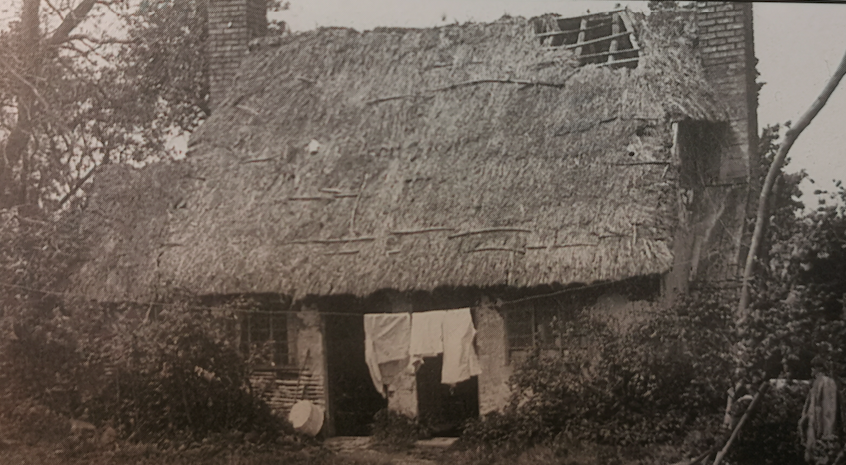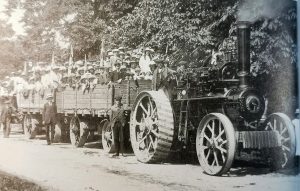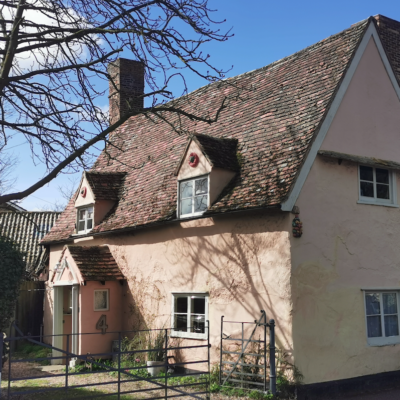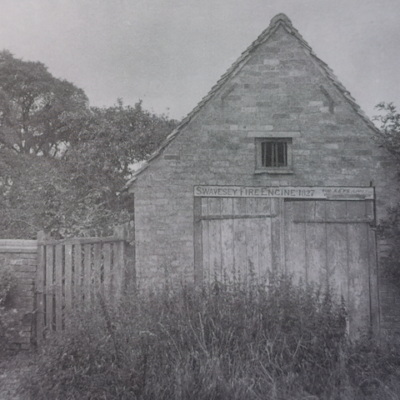Search by topic
- archaeology
- Building of Local Interest
- chapel
- charity
- church
- crime
- dressmaker
- fire
- Great Eastern Railway
- Listed building
- Mapping Relief
- medieval
- oral history
- poverty
- Public House
- Religious House
- Roman
- scholar
- school
- Then and Now
- tudor
- women
- work
- world war one
- world war two
Search by text
 Serf's house, Whaddon, 1921 (Cambridgeshire Collection)
Serf's house, Whaddon, 1921 (Cambridgeshire Collection)The Vicarage, Whaddon
History of the Vicarage, Whaddon
1901
John Gough Eames, 62, clergyman, b Ireland
Ann Katharine, 51, b Lancs
John Wallace, 18, b Glos.
Leigh Fairfax, 13, b Berks
Alice K Violet, niece, 30, b Ireland
Frances M L, niece, 25, b Ireland
Edith A De La Eames, 37, lady house keeper, b London
Ada M Butter, 17, housemaid, b Haslingfield
Nettie J Hopkins, 14, kitchenmaid, b Milton
Cambridge Independent Press 16/12/1904
SERIOUS FIRES. WHADDON VICARAGE BURNT DOWN. OVER £2,000 DAMAGE. A disastrous fire occurred at the village of Whaddon, near Melbourn, on Sunday afternoon, when the house of the Vicar (the Rev. John Gough Eames) and all its contents were entirely destroyed.
It appears that the fire originated in the pantry about 3-30 in the afternoon, and was accidentally caused by a paraffin lamp. Fourteen paraffin lamps were kept in the pantry, filled and trimmed ready for use. About three o’clock Mrs. Eames, the Vicar’s wife, went to the pantry for the drawing-room lamp. At the same time she lit an ordinary lamp, and left it burning in the pantry. Miss Eames went to the room about half-an hour later, and was horrified to find the place enveloped in flames. She immediately called her father, who, with the servants and others, made frantic efforts to extinguish the outbreak. Fed by the oil from the lamps, however, the fire burned furiously, and spread with great rapidity. The only water supply was a pump, and it soon became evident that it would be impossible to save the Vicarage from destruction.
The greater part of the fine old house was built of stud and plaster, and was enlarged and improved in 1877-8 at a cost of over £1,600. A large number of residents from the village and the surrounding district rendered assistance, and the Melbourn Fire Brigade attended, but all efforts to save anything from the devouring flames were in vain. The members of the County Police who attended and gave help were Superintendent Wilderspin, P.s. Salmon, and Police-constables Haylock and Frost.
The building was completely gutted, and all its contents, with the exception of two pianos and a small portion of the household plate, were destroyed. It is feared that the damage is considerably more than £2,000, for which sum the house and its contents were insured in the Manchester Office. Mr., Mrs. and Miss Eames and the servants have lost all their wearing apparel, with the exception of that they were wearing when the fire occurred. The Church Communion plate was in the Vicarage at the time, but fortunately this was recovered from the debris, although much of it is seriously damaged. Other pieces of plate and some valuable articles of jewellery are missing, but at the time of writing it was thought that these might possibly be recovered from the ruins. The plate and silver is not insured.
A Visit to Whaddon.
[By Our Own Reporter.]
On Wednesday afternoon a representative of the Independent Press visited Whaddon, with the view of obtaining a statement from the Vicar, and, although unsuccessful in this, the Vicar having gone to Royston, he was able to secure a detailed account of Sunday’s disastrous occurrence. Whaddon is a small, isolated village, set in unattractive surroundings, and situate equidistant from Meldreth, Bassingbourn, and Arrington, and about four miles from Royston. Seen in the gloom of a dark and wet December day, the prospect is anything but cheerful. The comfortable old house that has sheltered incumbents of the parish for many generations, stood in its own grounds a little distance from the road, and only few yards from the fine old Parish Church. It was screened from the road by a belt of trees, and the gardens and grounds were tastefully laid out and well cared for. In 1877 the building was enlarged and modernised at a cost of about £1,600, but the old timber interior was preserved. It appears that Mrs. Eames returned from Sunday School just before 3 o’clock, and the only other occupants of the house were the Vicar and Miss Eames. The reverend gentleman was enjoying a nap in the drawing-room, and his, daughter was engaged in writing letters in her bedroom. Mrs. Eames was preparing for a boys’ Bible Class, which is conducted by her on Sunday afternoons in the dining-room at the Vicarage. The two maids and the housekeeper were attending a Bible Class at the School. Mrs. Eames went to the pantry, where several paraffin lamps, to the number of about a dozen, were kept filled with oil, trimmed, and ready for use. She lit the dining-room lamp, and took it into the room, where the boys were assembled, leaving a smaller lamp burning on the table in the pantry near the others. At twenty minutes past three, Miss Eames, who was still upstairs, was attracted by smoke and a strong smell of fire, and she immediately went down to investigate. Passing through the kitchen, she was driven back by a cloud of smoke and a wave of flame proceeding from the pantry. She quickly roused her father and raised an alarm. Some of the Bible Class boys ran down to the village to summon the servants and call for assistance.
THE CHURCH BELLS RING THE ALARM.
At the suggestion of one of the servants, the bells of the Parish Church were rung, and many people from the surrounding district were attracted to the scene by this unusual proceeding. Help was soon forthcoming. Meanwhile, the fire had spread with amazing rapidity. The flames raced along both staircases, cutting off access to the upstairs rooms, attacked the roof, and it was soon apparent that there could be no hope of saving any portion of the building. The old woodwork shell lining the inside of the brick walls, crackled and blazed, and, to use the words of the housekeeper, “the house burned like a matchbox.”
The nearest fire engines were at Melbourn and Royston, and the former was sent for. Water was scarce, the only supply for the house being obtained from a pump, and even this failed on this occasion. The farmers of the neighbourhood rendered good service with their watercarts, thus enabling the Fire Brigade, which appeared on the scene shortly after 4 o’clock, to save the outbuildings. It was useless to attempt save the house or its contents, although the servants had managed to throw out portions of the furniture of the dining, drawing, and morning rooms. This was carried for safety into the Church, where it remains. Aided by a band of hard-working villagers, the Melbourn Fire Brigade saved the outbuildings and the horses and carriages.
THE END.
A few minutes after the arrival of the Brigade, and only about three-quarters of an hour after the discovery of the fire, the roof of the Vicarage fell with a crash, and the flames leapt high into the air. The heat was terrific, and the roaring, crackling mass was quite unapproachable. In about an hour all was practically over. The fire raged furiously for a time, but everything was quickly consumed. The outer walls commenced to lean and totter, and portions fell, while others, which were dangerously insecure, were thrown down.
Later in the evening crowds of people from the surrounding district visited the spot, and gazed upon the blackened, smoking ruins. Nothing remains of the house but a heap of ruins, pieces of broken, twisted iron, and pieces of charred and smouldering wood, with portions of the walls still standing. The conservatory, a lean-to glass structure, is practically intact.
CHURCH PLATE SAVED.
As previously stated, the Church Communion plate was recovered from the debris. The chalice and patens, though discoloured, are whole, and not defaced or bent. The bottom of the flagon had melted, but the handle, the top part, and the inscription are intact. The house and the buildings were insured in the Manchester Fire Office, and the furniture, etc., was insured with Alliance Company to the amount of £500. The Vicar’s pecuniary loss will therefore not be very great, but unfortunately many highly prized heirlooms were destroyed.
The cause of the fire can only be a matter of conjecture. It undoubtedly originated in the pantry, and it is thought that the lamp which Mrs. Eames left burning in the pantry must have exploded, although no report was heard. Needless to say, the utmost sympathy is felt in the district for the Vicar. He and his family are now staying at The Moor, where they are the guests of Mrs. Palmer.
1921
The serf’s house in the photo was behind cottages facing the vicarage and had been demolished by 1926. Even though damaged by 1921 it was still inhabited.
Contribute
Do you have any information about the people or places in this article? If so, then please let us know using the Contact page or by emailing capturingcambridge@
License
This work is licensed under CC BY-NC-SA 4.0








